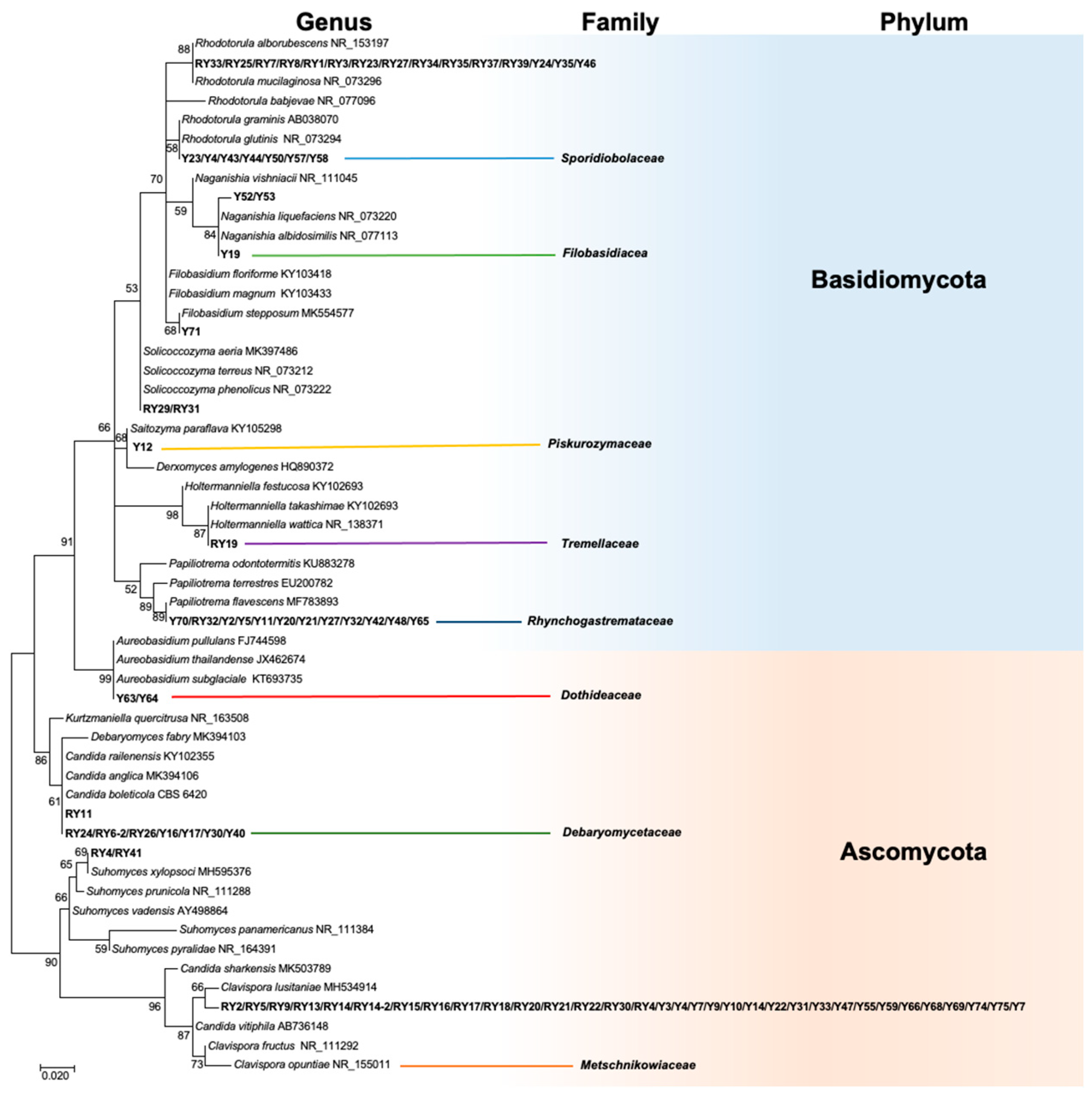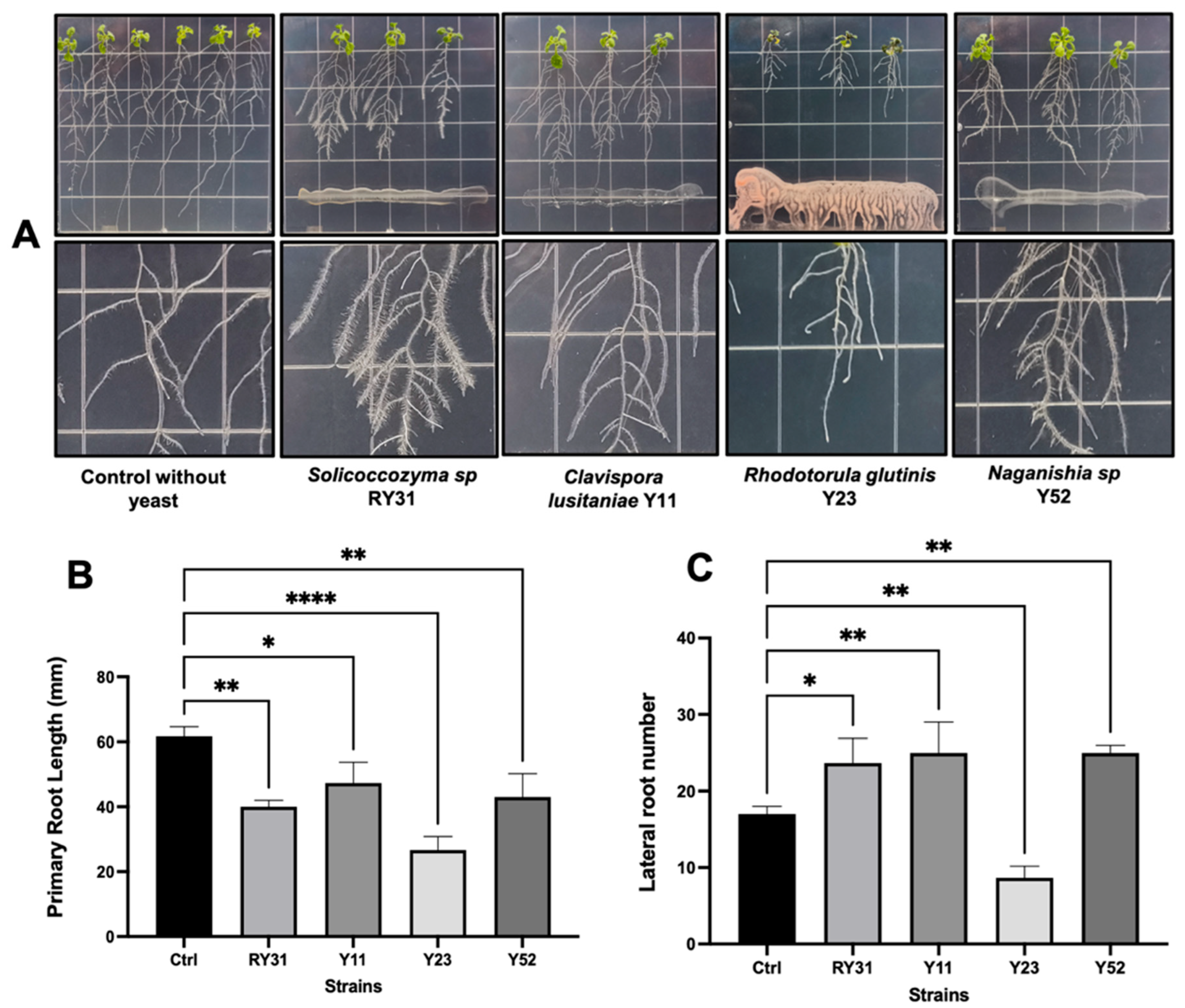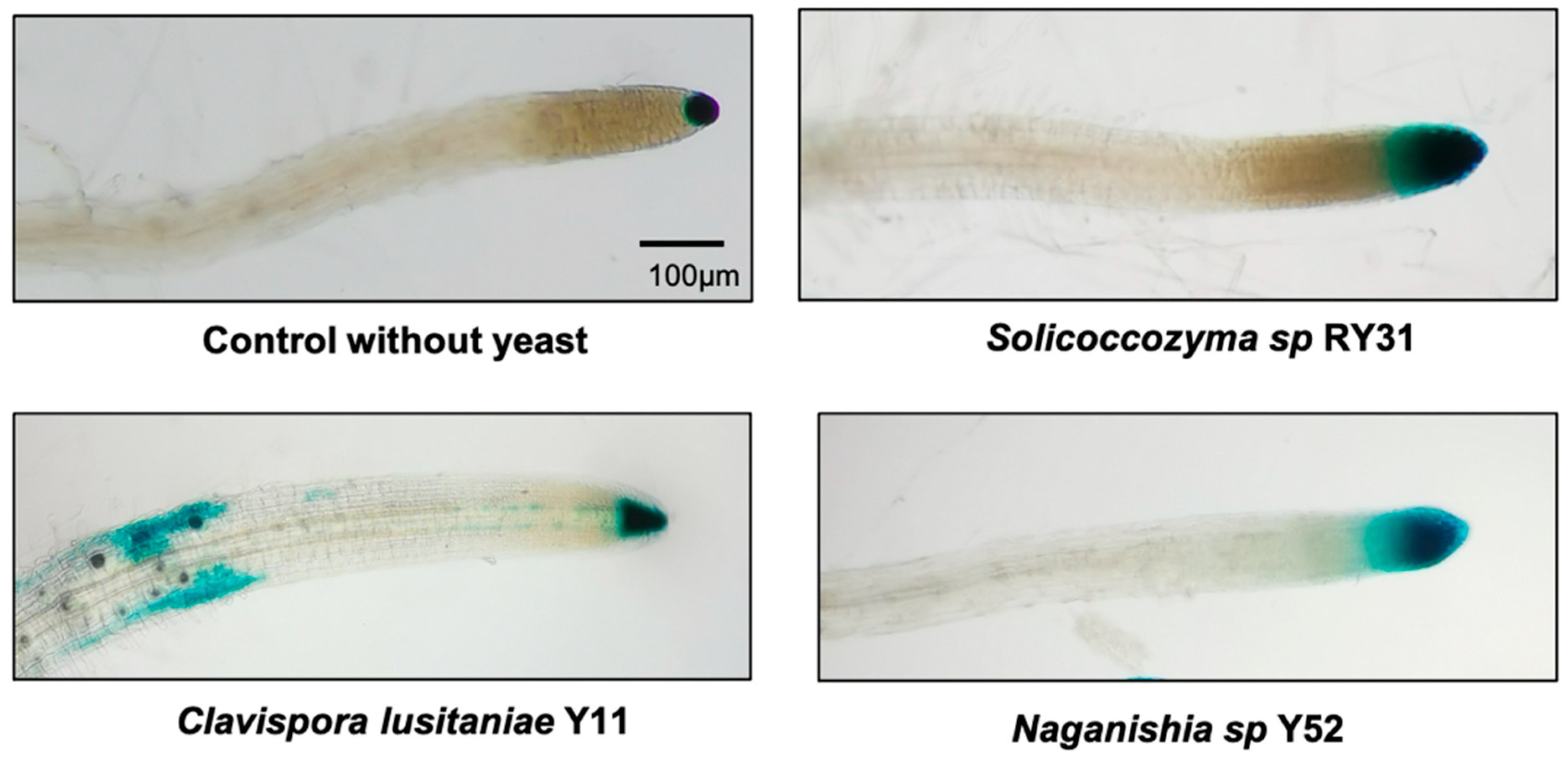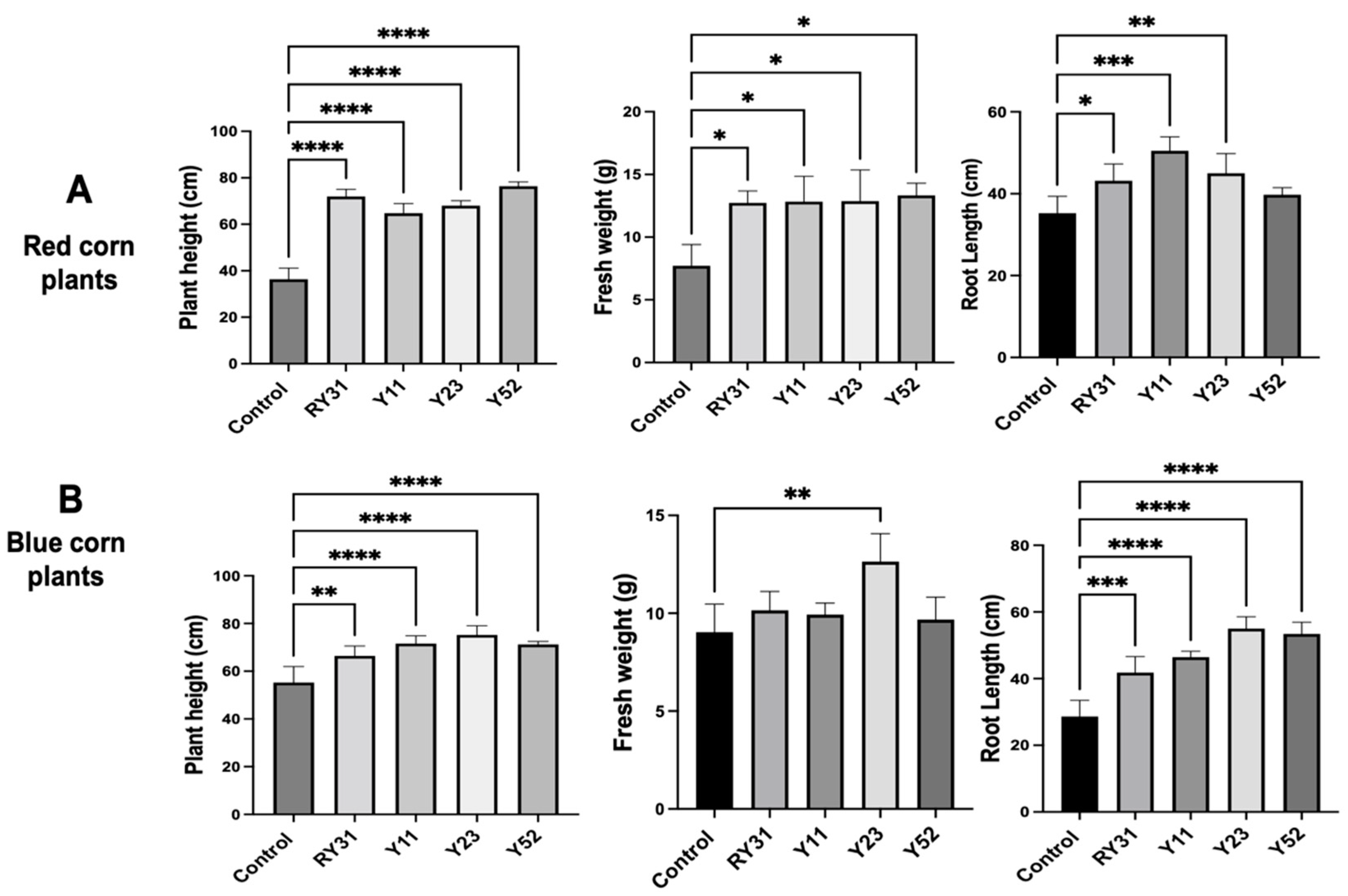Mycobiota of Mexican Maize Landraces with Auxin-Producing Yeasts That Improve Plant Growth and Root Development
Abstract
1. Introduction
2. Results and Discussion
2.1. Yeast Diversity Associated with Maize Plants
2.2. Plant Growth-Promoting Characteristics
2.3. Auxin Production
2.4. Arabidopsis Thaliana-Yeast Interaction Assays
2.5. Evaluation of Auxin-Producing Yeasts as Bioinoculants
3. Materials and Methods
3.1. Maize Accessions
3.2. Isolation and Identification of Yeast Strains
3.2.1. Yeast Strain Isolation
3.2.2. Molecular Identification and Phylogenetic Analysis
3.3. Plant Growth-Promoting Characteristics
3.3.1. Solubilization of Phosphate
3.3.2. Siderophore Quantification
3.3.3. Production of Plant Cell Wall-Degrading Enzymes
3.4. Analysis of Auxin Production
3.4.1. Auxin Production in Culture Media
3.4.2. Induction of Auxin Production by Root Exudates
3.5. Arabidopsis Thaliana-Yeast Interaction Assays
3.6. Evaluation of Auxin-Producing Yeasts as a Bioinoculant
3.7. Statistical Analysis
4. Conclusions
Supplementary Materials
Author Contributions
Funding
Data Availability Statement
Acknowledgments
Conflicts of Interest
References
- Sharma, N.; Singhvi, R. Effects of chemical fertilizers and pesticides on human health and environment: A review. Int. J. Agric. Environ. Biotechnol. 2017, 10, 675–679. [Google Scholar] [CrossRef]
- Ghaly, A.E.; Ramakrishnan, V.V. Nitrogen sources and cycling in the ecosystem and its role in air, water and soil pollution: A critical review. J. Pollut. Eff. Control 2015, 3, 1–26. [Google Scholar] [CrossRef]
- Erenstein, O.; Jaleta, M.; Sonder, K.; Mottaleb, K.; Prasanna, B. Global maize production, consumption and trade: Trends and R&D implications. Food Secur. 2022, 14, 1295–1319. [Google Scholar] [CrossRef]
- Barrera-Guzmán, L.A.; Legaria-Solano, J.P.; Ortega-Paczka, R. Genetic diversity in populations of Mexican maize races. Rev. Fitotec. Mex. 2020, 43, 121–125. [Google Scholar] [CrossRef]
- Zelaya-Molina, L.X.; Sanchez-Lima, A.D.; Arteaga-Garibay, R.I.; Bustamante-Brito, R.; Vásquez-Murrieta, M.S.; Martínez-Romero, E.; Ramos-Garza, J. Functional characterization of culturable fungi from microbiomes of the “conical cobs” Mexican maize (Zea mays L.) landrace. Arch. Microbiol. 2022, 204, 57. [Google Scholar] [CrossRef] [PubMed]
- Maitra, S.; Brestic, M.; Bhadra, P.; Shankar, T.; Praharaj, S.; Palai, J.B.; Shah, M.; Barek, V.; Ondrisik, P.; Skalický, M.; et al. Bioinoculants—Natural Biological Resources for Sustainable Plant Production. Microorganisms 2022, 10, 51. [Google Scholar] [CrossRef] [PubMed]
- Thomas, L.; Singh, I. Microbial biofertilizers: Types and applications. In Biofertilizers for Sustainable Agriculture and Environment; Giri, B., Prasad, R., Wu, Q.S., Varma, A., Eds.; Springer: Cham, Switzerland, 2019; pp. 1–19. [Google Scholar] [CrossRef]
- Mahanty, T.; Bhattacharjee, S.; Goswami, M.; Bhattacharyya, P.; Das, B.; Ghosh, A.; Tribedi, P. Biofertilizers: A potential approach for sustainable agriculture development. Environ. Sci. Pollut. Res. 2017, 24, 3315–3335. [Google Scholar] [CrossRef]
- Igiehon, N.O.; Babalola, O.O. Biofertilizers and sustainable agriculture: Exploring arbuscular mycorrhizal fungi. Appl. Microbiol. Biotechnol. 2017, 101, 4871–4881. [Google Scholar] [CrossRef] [PubMed]
- Shruthi, B.; Deepa, N.; Somashekaraiah, R.; Adithi, G.; Divyashree, S.; Sreenivasa, M.Y. Exploring biotechnological and functional characteristics of probiotic yeasts: A review. Biotechnol. Rep. 2022, 34, e00716. [Google Scholar] [CrossRef]
- Yurkov, A.M. Yeasts of the soil—obscure but precious. Yeast 2018, 35, 369–378. [Google Scholar] [CrossRef]
- Kowalska, J.; Krzymińska, J.; Tyburski, J. Yeasts as a Potential Biological Agent in Plant Disease Protection and Yield Improvement—A Short Review. Agriculture 2022, 12, 1404. [Google Scholar] [CrossRef]
- Mukherjee, A.; Verma, J.P.; Gaurav, A.K.; Chouhan, G.K.; Patel, J.S.; Hesham, A.E. Yeast a potential bio-agent: Future for plant growth and postharvest disease management for sustainable agriculture. Appl. Microbiol. Biotechnol. 2020, 104, 1497–1510. [Google Scholar] [CrossRef] [PubMed]
- Kapoor, D.; Karnwal, A. Yeast as plant growth promoter and biocontrol agent. In Fungi Bio-Prospects in Sustainable Agriculture, Environment and Nano-Technology: Fungal Diversity of Sustainable Agriculture; Sharma, V.K., Shah, M., Parmar, S., Kumar, A., Eds.; Elsevier: Amsterdam, The Netherlands, 2020; Volume 1, pp. 429–457. [Google Scholar] [CrossRef]
- Hesham, A.E.L.; Mohamed, H.M. Molecular Genetic Identification of Yeast Strains Isolated from Egyptian Soils for Solubilization of Inorganic Phosphates and Growth Promotion of Corn Plants. J. Microbiol. Biotechnol. 2011, 21, 55–61. [Google Scholar] [CrossRef]
- Lesuisse, E.; Blaiseau, P.-L.; Dancis, A.; Camadro, J.-M. Siderophore Uptake and Use by the Yeast Saccharomyces cerevisiae. Microbiology 2001, 147, 289–298. [Google Scholar] [CrossRef] [PubMed]
- El-Tarabily, K.A.; Sivasithamparam, K. Potential of yeasts as biocontrol agents of soil-borne fungal plant pathogens and as plant growth promoters. Mycoscience 2006, 47, 25–35. [Google Scholar] [CrossRef]
- Raacke, I.C.; Von Rad, U.; Mueller, M.J.; Berger, S. Yeast Increases Resistance in Arabidopsis Against Pseudomonas syringae and Botrytis cinerea by Salicylic Acid-Dependent as Well as -Independent Mechanisms. Mol. Plant-Microbe Interact. 2006, 19, 1138–1146. [Google Scholar] [CrossRef]
- Gomes, G.L.B.; Scortecci, K.C. Auxin and its role in plant development: Structure, signalling, regulation and response mechanisms. Plant Biol. 2021, 23, 894–904. [Google Scholar] [CrossRef]
- Zhang, Q.; Gong, M.; Xu, X.; Li, H.; Deng, W. Roles of Auxin in the Growth, Development, and Stress Tolerance of Horticultural Plants. Cells 2022, 11, 2761. [Google Scholar] [CrossRef]
- Streletskii, R.A.; Kachalkin, A.V.; Glushakova, A.M.; Demin, V.V.; Chernov, I.Y. Quantitative determination of indole-3-acetic acid in yeasts using high performance liquid chromatography-tandem mass spectrometry. Microbiology 2016, 85, 727–736. [Google Scholar] [CrossRef]
- Into, P.; Pontes, A.; Sampaio, J.P.; Limtong, S. Yeast diversity associated with the phylloplane of corn plants cultivated in Thailand. Microorganisms 2020, 8, 80. [Google Scholar] [CrossRef]
- De Lima Targino, H.M.; Silva, V.S.L.; Escobar, I.E.C.; de Almeida Ribeiro, P.R.; Gava, C.A.T.; Fernandes-Júnior, P.I. Maize-associated Meyerozyma from the Brazilian semiarid region are effective plant growth-promoting yeasts. Rhizosphere 2022, 22, 100538. [Google Scholar] [CrossRef]
- Lopez-Guerrero, M.G.; Wang, P.; Phares, F.; Schachtman, D.P.; Alvarez, S.; van Dijk, K. A glass bead semi-hydroponic system for intact maize root exudate analysis and phenotyping. Plant Methods 2022, 18, 25. [Google Scholar] [CrossRef] [PubMed]
- Drumonde-Neves, J.; Čadež, N.; Domínguez, Y.R.; Gallmetzer, A.; Schuller, D.; Lima, T.; Pais, C.; Franco-Duarte, R. Clavispora santaluciae f.a., sp. nov., a novel ascomycetous yeast species isolated from grapes. Int. J. Syst. Evol. Microbiol. 2020, 70, 6307–6312. [Google Scholar] [CrossRef]
- Camarena-Pozos, D.A.; Flores-Núñez, V.M.; López, M.G.; López-Bucio, J.; Partida-Martínez, L.P. Smells from the desert: Microbial volatiles that affect plant growth and development of native and non-native plant species. Plant Cell Environ. 2019, 42, 1368–1380. [Google Scholar] [CrossRef] [PubMed]
- El-Tarabily, K.A. Suppression of Rhizoctonia solani diseases of sugar beet by antagonistic and plant growth-promoting yeasts. J. Appl. Microbiol. 2004, 96, 69–75. [Google Scholar] [CrossRef]
- Joubert, P.M.; Doty, S.L. Endophytic Yeasts: Biology, Ecology and Applications. In Endophytes of Forest Trees: Biology and Applications; Pirttilä, A.M., Frank, A.C., Eds.; Springer International Publishing: Cham, Switzerland, 2018; pp. 3–14. ISBN 978-3-319-89833-9. [Google Scholar] [CrossRef]
- Ramos-Garza, J.; Bustamante-Brito, R.; Angeles de Paz, G.; Medina-Canales, M.G.; Vásquez-Murrieta, M.S.; Wang, E.T.; Rodríguez-Tovar, A.V. Isolation and characterization of yeasts associated with plants growing in heavy-metal-and arsenic-contaminated soils. Can. J. Microbiol. 2016, 62, 307–319. [Google Scholar] [CrossRef] [PubMed]
- Limtong, S.; Kaewwichian, R.; Yongmanitchai, W.; Kawasaki, H. Diversity of culturable yeasts in phylloplane of sugarcane in Thailand and their capability to produce indole-3-acetic acid. World J. Microbiol. Biotechnol. 2014, 30, 1785–1796. [Google Scholar] [CrossRef] [PubMed]
- Di Francesco, A.; Zajc, J.; Stenberg, J.A. Aureobasidium spp.: Diversity, Versatility, and Agricultural Utility. Horticulturae 2023, 9, 59. [Google Scholar] [CrossRef]
- Filippucci, S.; Tasselli, G.; Scardua, A.; Di Mauro, S.; Cramarossa, M.R.; Perini, D.; Turchetti, B.; Onofri, A.; Forti, L.; Buzzini, P. Study of Holtermanniella wattica, Leucosporidium creatinivorum, Naganishia adeliensis, Solicoccozyma aeria, and Solicoccozyma terricola for their lipogenic aptitude from different carbon sources. Biotechnol. Biofuels 2016, 9, 259. [Google Scholar] [CrossRef]
- Gorte, O.; Kugel, M.; Ochsenreither, K. Optimization of carbon source efficiency for lipid production with the oleaginous yeast Saitozyma podzolica DSM 27192 applying automated continuous feeding. Biotechnol. Biofuels 2020, 13, 181. [Google Scholar] [CrossRef]
- Carvajal, M.; Godoy, L.; Gebauer, M.; Catrileo, D.; Albornoz, F. Screening for indole-3-acetic acid synthesis and 1-aminocyclopropane-carboxylate deaminase activity in soil yeasts from Chile uncovers Solicoccozyma aeria as an effective plant growth promoter. Plant Soil 2023, 1–11. [Google Scholar] [CrossRef]
- Carvalhais, L.C.; Dennis, P.G.; Fedoseyenko, D.; Hajirezaei, M.; Borriss, R.; von Wirén, N. Root exudation of sugars, amino acids, and organic acids by maize as affected by nitrogen, phosphorus, potassium, and iron deficiency. J. Plant Nutr. Soil Sci. 2011, 174, 3–11. [Google Scholar] [CrossRef]
- Xiao, C.; Chi, R.; Pan, X.; Liu, F.; He, J. Rock phosphate solubilization by four yeast strains. Ann. Microbiol. 2013, 63, 173–178. [Google Scholar] [CrossRef]
- Chen, Y.R.; Kuo, C.Y.; Fu, S.F.; Chou, J.Y. Plant growth-promoting properties of the phosphate-solubilizing red yeast Rhodosporidium paludigenum. World J. Microbiol. Biotechnol. 2023, 39, 54. [Google Scholar] [CrossRef]
- Sarabia, M.; Jakobsen, I.; Grønlund, M.; Carreon-Abud, Y.; Larsen, J. Rhizosphere yeasts improve P uptake of a maize arbuscular mycorrhizal association. Appl. Soil Ecol. 2018, 125, 18–25. [Google Scholar] [CrossRef]
- Chen, R.Y.; Jiang, W.; Fu, S.F.; Chou, J.Y. Screening, evaluation, and selection of yeasts with high ammonia production ability under nitrogen free condition from the cherry tomato (Lycopersicon esculentum var. cerasiforme) rhizosphere as a potential bio-fertilizer. Rhizosphere 2022, 23, 100580. [Google Scholar] [CrossRef]
- Convertini, S.; Shaarawi, S.A.; Nigro, F. Activity and Siderophores Production by Rhodotorula spp. Isolates, Potential Antagonists of Botrytis Storage Rot. Egypt. J. Hortic. 2015, 42, 453–468. [Google Scholar] [CrossRef]
- Gouka, L.; Raaijmakers, J.M.; Cordovez, V. Ecology and functional potential of phyllosphere yeasts. Trends Plant Sci. 2022, 27, 1109–1123. [Google Scholar] [CrossRef]
- Cuaxinque-Flores, G.; Aguirre-Noyola, J.L.; Hernández-Flores, G.; Martínez-Romero, E.; Romero-Ramírez, Y.; Talavera-Mendoza, O. Bioimmobilization of Toxic Metals by Precipitation of Carbonates Using Sporosarcina luteola: An in Vitro Study and Application to Sulfide-Bearing Tailings. Sci. Total Environ. 2020, 724, 138124. [Google Scholar] [CrossRef]
- Domka, A.; Jędrzejczyk, R.; Ważny, R.; Gustab, M.; Kowalski, M.; Nosek, M.; Bizan, J.; Puschenreiter, M.; Vaculίk, M.; Kováč, J.; et al. Endophytic yeast protect plants against metal toxicity by inhibiting plant metal uptake through an ethylene-dependent mechanism. Plant Cell Environ. 2023, 46, 268–287. [Google Scholar] [CrossRef]
- Deng, Z.; Wang, W.; Tan, H.; Cao, L. Characterization of heavy metal-resistant endophytic yeast Cryptococcus sp. CBSB78 from rapes (Brassica chinensis) and its potential in promoting the growth of Brassica spp. in metal-contaminated soils. Water Air Soil Pollut. 2012, 223, 5321–5329. [Google Scholar] [CrossRef]
- Parmar, T.S.; Ahirwar, R.; Sahay, S. Isolation, purification and characterization of carboxymethyl cellulase (CMCase) from psychrotolerant yeast Rhodotorula mucilaginosa BPT1. Mater. Today Proc. 2023, 72, 2768–2772. [Google Scholar] [CrossRef]
- Schulz, B.; Boyle, C. The endophytic continuum. Mycol. Res. 2005, 109, 661–686. [Google Scholar] [CrossRef] [PubMed]
- Freimoser, F.M.; Rueda-Mejia, M.P.; Tilocca, B.; Migheli, Q. Biocontrol yeasts: Mechanisms and applications. World J. Microbiol. Biotechnol. 2019, 35, 154. [Google Scholar] [CrossRef]
- Reddy, P.V.; Lam, C.K.; Belanger, F.C. Mutualistic fungal endophytes express a proteinase that is homologous to proteases suspected to be important in fungal pathogenicity. Plant Physiol. 1996, 111, 1209–1218. [Google Scholar] [CrossRef]
- Nutaratat, P.; Srisuk, N.; Arunrattiyakorn, P.; Limtong, S. Indole-3-acetic acid biosynthetic pathways in the basidiomycetous yeast Rhodosporidium paludigenum. Arch. Microbiol. 2016, 198, 429–437. [Google Scholar] [CrossRef]
- Nassar, A.H.; El-Tarabily, K.A.; Sivasithamparam, K. Promotion of plant growth by an auxin-producing isolate of the yeast Williopsis saturnus endophytic in maize (Zea mays L.) roots. Biol. Fertil. Soils 2005, 42, 97–108. [Google Scholar] [CrossRef]
- Bunsangiam, S.; Sakpuntoon, V.; Srisuk, N.; Ohashi, T.; Fujiyama, K.; Limtong, S. Biosynthetic Pathway of Indole-3-Acetic Acid in Basidiomycetous Yeast Rhodosporidiobolus fluvialis. Mycobiology 2019, 47, 292–300. [Google Scholar] [CrossRef]
- Bispo, R.L.B.; Ceccato-Antonini, S.R.; Tosta, C.D.; Fontanetti, A.; Prado, V.S.; Takita, M.A.; Rosa-Magri, M.M. Sugarcane molasses as substrate to soil yeasts: Indole-3-acetic acid production and maize initial growth promotion. Biocatal. Agric. Biotechnol. 2023, 47, 102618. [Google Scholar] [CrossRef]
- Nicastro, R.; Raucci, S.; Michel, A.H.; Stumpe, M.; Garcia Osuna, G.M.; Jaquenoud, M.; Kornmann, B.; De Virgilio, C. Indole-3-acetic acid is a physiological inhibitor of TORC1 in yeast. PLoS Genet. 2021, 17, e1009414. [Google Scholar] [CrossRef]
- Fu, S.F.; Chen, H.W.; Wei, J.Y.; Lee, Y.I.; Chou, J.Y. Yeast-produced IAA is not only involved in the competition among yeasts but also promotes plant growth and development. Nova Hedwig. 2017, 105, 135–150. [Google Scholar] [CrossRef]
- Fu, S.F.; Sun, P.F.; Lu, H.Y.; Wei, J.Y.; Xiao, H.S.; Fang, W.T.; Cheng, B.Y.; Chou, J.Y. Plant growth-promoting traits of yeasts isolated from the phyllosphere and rhizosphere of Drosera spatulata Lab. Fungal Biol. 2016, 120, 433–448. [Google Scholar] [CrossRef]
- Sun, P.-F.; Fang, W.-T.; Shin, L.-Y.; Wei, J.-Y.; Fu, S.-F.; Chou, J.-Y. Indole-3-Acetic Acid-Producing Yeasts in the Phyllosphere of the Carnivorous Plant Drosera indica L. PLoS ONE 2014, 9, e114196. [Google Scholar] [CrossRef] [PubMed]
- Fernandez-San Millan, A.; Farran, I.; Larraya, L.; Ancin, M.; Arregui, L.M.; Veramendi, J. Plant growth-promoting traits of yeasts isolated from Spanish vineyards: Benefits for seedling development. Microbiol. Res. 2020, 237, 126480. [Google Scholar] [CrossRef] [PubMed]
- Chen, Y.; Yordanov, Y.S.; Ma, C.; Strauss, S.; Busov, V.B. DR5 as a reporter system to study auxin response in Populus. Plant Cell Rep. 2013, 32, 453–463. [Google Scholar] [CrossRef]
- Bettio, G.; Zardo, L.C.; Rosa, C.A.; Ayub, M.A.Z. Bioconversion of ferulic acid into aroma compounds by newly isolated yeast strains of the Latin American biodiversity. Biotechnol. Prog. 2021, 37, e3067. [Google Scholar] [CrossRef] [PubMed]
- Zhang, H.; Yang, Y.; Mei, X.; Li, Y.; Wu, J.; Li, Y.; Wang, H.; Huang, H.; Yang, M.; He, X.; et al. Phenolic Acids Released in Maize Rhizosphere During Maize-Soybean Intercropping Inhibit Phytophthora Blight of Soybean. Front. Plant Sci. 2020, 11, 886. [Google Scholar] [CrossRef]
- Khan, S.T. Consortia-based microbial inoculants for sustaining agricultural activities. Appl. Soil Ecol. 2022, 176, 104503. [Google Scholar] [CrossRef]
- Gómez-Godínez, L.J.; Fernandez-Valverde, S.L.; Martinez Romero, J.C.; Martínez-Romero, E. Metatranscriptomics and nitrogen fixation from the rhizoplane of maize plantlets inoculated with a group of PGPRs. Syst. Appl. Microbiol. 2019, 42, 517–525. [Google Scholar] [CrossRef]
- CONABIO. Cónico. 2020. Available online: https://www.biodiversidad.gob.mx/diversidad/alimentos/maices/razas/grupo-conico/conico (accessed on 3 February 2023).
- Ramos-Garza, J.; Rodríguez-Tovar, A.V.; Flores-Cotera, L.B.; Rivera-Orduña, F.N.; Vásquez-Murrieta, M.S.; Ponce-Mendoza, A.; Wang, E.T. Diversity of fungal endophytes from the medicinal plant Dendropanax arboreus in a protected area of Mexico. Ann. Microbiol. 2016, 66, 991–1002. [Google Scholar] [CrossRef]
- Gardes, M.; Bruns, T.D. ITS primers with enhanced specificity for basidiomycetes-application to the identification of mycorrhizae and rusts. Mol. Ecol. 1993, 2, 113–118. [Google Scholar] [CrossRef]
- White, T.J.; Bruns, T.; Lee, S.; Taylor, J. Amplification and direct sequencing of fungal ribosomal RNA Genes for phylogenetics. In PCR Protocols: A Guide to Methods and Applications; Academic Press: New York, NY, USA, 1990; pp. 315–322. [Google Scholar]
- Hall, T. BioEdit, version 7.2.5; Ibis Biosciences: Carlsbad, CA, USA, 2013. [Google Scholar]
- Xia, X. DAMBE7: New and improved tools for data analysis in molecular biology and evolution. Mol. Biol. Evol. 2018, 35, 1550–1552. [Google Scholar] [CrossRef]
- Darriba, D.; Taboada, G.L.; Doallo, R.; Posada, D. jModelTest 2: More models, new heuristics and parallel computing. Nat. Methods 2012, 9, 772. [Google Scholar] [CrossRef]
- Tamura, K.; Stecher, G.; Peterson, D.; Filipski, A.; Kumar, S. MEGA6: Molecular evolutionary genetics analysis version 6.0. Mol. Biol. Evol. 2013, 30, 2725–9272. [Google Scholar] [CrossRef]
- Nopparat, C.; Jatupornpipat, M.; Rittiboon, A. Isolation of phosphate solubilizing fungi in soil from Kanchanaburi, Thailand. Curr. Appl. Sci. Technol. 2007, 7, 137–146. [Google Scholar]
- Grimm, P.W.; Allen, P.J. Promotion by zinc of the formation of cytochromes in Ustilago sphaerogena. Plant Physiol. 1954, 29, 369–378. [Google Scholar] [CrossRef]
- Maldonado-Hernández, J.; Román-Ponce, B.; Arroyo-Herrera, I.; Guevara-Luna, J.; Ramos-Garza, J.; Embarcadero-Jiménez, S.; Vásquez-Murrieta, M.S. Metallophores production by bacteria isolated from heavy metal-contaminated soil and sediment at Lerma–Chapala Basin. Arch. Microbiol. 2022, 204, 180. [Google Scholar] [CrossRef]
- Chowdappa, S.; Jagannath, S.; Konappa, N.; Udayashankar, A.C.; Jogaiah, S. Detection and characterization of antibacterial siderophores secreted by endophytic fungi from Cymbidium aloifolium. Biomolecules 2020, 10, 1412. [Google Scholar] [CrossRef]
- Castañeda-Agulló, M. Studies on the biosynthesis of extracellular proteases by bacteria: I. Serratia marcescens synthetic and gelatin media. J. Gen. Physiol. 1956, 39, 369. [Google Scholar] [CrossRef]
- Hankin, L.; Anagnostakis, S. Solid media containing carboxy methyl cellulose to detect CM cellulase activity of microorganisms. Microbiology 1977, 98, 109–115. [Google Scholar] [CrossRef]
- Herrera-Quiterio, A.; Toledo-Hernández, E.; Aguirre-Noyola, J.L.; Romero, Y.; Ramos, J.; Palemón-Alberto, F.; Toribio-Jiménez, J. Antagonic and plant growth-promoting effects of bacteria isolated from mine tailings at El Fraile, Mexico. Rev. Argent. Microbiol. 2020, 52, 231–239. [Google Scholar] [CrossRef]
- Rosenblueth, M.; Martinez-Romero, E. Rhizobium. etli maize populations and their competitiveness for root colonization. Arch. Microbiol. 2004, 181, 337–344. [Google Scholar] [CrossRef]
- Aguirre-Noyola, J.L.; Rosenblueth, M.; Santiago-Martínez, M.G.; Martínez-Romero, E. Transcriptomic Responses of Rhizobium phaseoli to Root Exudates Reflect Its Capacity to Colonize Maize and Common Bean in an Intercropping System. Front. Microbiol. 2021, 12, 740818. [Google Scholar] [CrossRef]
- Matus-Acuña, V.; Caballero-Flores, G.; Reyes-Hernandez, B.J.; Martínez-Romero, E. Bacterial preys and commensals condition the effects of bacteriovorus nematodes on Zea mays and Arabidopsis thaliana. Appl. Soil Ecol. 2018, 132, 99–106. [Google Scholar] [CrossRef]
- Jefferson, R.A.; Kavanagh, T.A.; Bevan, M.W. GUS fusions: Beta-glucuronidase as a sensitive and versatile gene fusion marker in higher plants. EMBO J. 1987, 6, 3901–3907. [Google Scholar] [CrossRef]
- Fåhraeus, G. The infection of clover root hairs by nodule bacteria studied by a simple glass slide technique. Microbiology 1957, 16, 374–381. [Google Scholar] [CrossRef]






| Strain | YPD Broth (µg/mL) | YPD Broth + L- Tryptophan (µg/mL) | YPD Broth + Root Exudates of Red Maize (µg/mL) | YPD Broth + Root Exudates of Blue Maize (µg/mL) |
|---|---|---|---|---|
| Solicoccozyma sp. RY31 | 9.3 ± 2.4 b | 27.1 ± 1.6 b | 22.5 ± 9.7 a | 14.1 ± 3.0 b |
| Clavispora lusitaniae Y11 | 4 ± 0.3 d | 11.9 ± 1.9 c | 1.3 ± 0.2 c | 5.9 ± 0.3 d |
| Rhodotorula glutinis Y23 | 7.1 ± 0.1 c | 52 ± 4.2 a | 8.3 ± 0.5 b | 9.36 ± 1.2 c |
| Naganishia sp. Y52 | 15.8 ± 1.8 a | 22.3 ± 0.6 b | 19.0 ± 7.7 a | 20 ± 7.1 a |
Disclaimer/Publisher’s Note: The statements, opinions and data contained in all publications are solely those of the individual author(s) and contributor(s) and not of MDPI and/or the editor(s). MDPI and/or the editor(s) disclaim responsibility for any injury to people or property resulting from any ideas, methods, instructions or products referred to in the content. |
© 2023 by the authors. Licensee MDPI, Basel, Switzerland. This article is an open access article distributed under the terms and conditions of the Creative Commons Attribution (CC BY) license (https://creativecommons.org/licenses/by/4.0/).
Share and Cite
Ramos-Garza, J.; Aguirre-Noyola, J.L.; Bustamante-Brito, R.; Zelaya-Molina, L.X.; Maldonado-Hernández, J.; Morales-Estrada, A.I.; Resendiz-Venado, Z.; Palacios-Olvera, J.; Angeles-Gallegos, T.; Terreros-Moysen, P.; et al. Mycobiota of Mexican Maize Landraces with Auxin-Producing Yeasts That Improve Plant Growth and Root Development. Plants 2023, 12, 1328. https://doi.org/10.3390/plants12061328
Ramos-Garza J, Aguirre-Noyola JL, Bustamante-Brito R, Zelaya-Molina LX, Maldonado-Hernández J, Morales-Estrada AI, Resendiz-Venado Z, Palacios-Olvera J, Angeles-Gallegos T, Terreros-Moysen P, et al. Mycobiota of Mexican Maize Landraces with Auxin-Producing Yeasts That Improve Plant Growth and Root Development. Plants. 2023; 12(6):1328. https://doi.org/10.3390/plants12061328
Chicago/Turabian StyleRamos-Garza, Juan, José Luis Aguirre-Noyola, Rafael Bustamante-Brito, Lily X. Zelaya-Molina, Jessica Maldonado-Hernández, Aurea Itzel Morales-Estrada, Zoe Resendiz-Venado, Jacqueline Palacios-Olvera, Thania Angeles-Gallegos, Paola Terreros-Moysen, and et al. 2023. "Mycobiota of Mexican Maize Landraces with Auxin-Producing Yeasts That Improve Plant Growth and Root Development" Plants 12, no. 6: 1328. https://doi.org/10.3390/plants12061328
APA StyleRamos-Garza, J., Aguirre-Noyola, J. L., Bustamante-Brito, R., Zelaya-Molina, L. X., Maldonado-Hernández, J., Morales-Estrada, A. I., Resendiz-Venado, Z., Palacios-Olvera, J., Angeles-Gallegos, T., Terreros-Moysen, P., Cortés-Carvajal, M., & Martínez-Romero, E. (2023). Mycobiota of Mexican Maize Landraces with Auxin-Producing Yeasts That Improve Plant Growth and Root Development. Plants, 12(6), 1328. https://doi.org/10.3390/plants12061328










